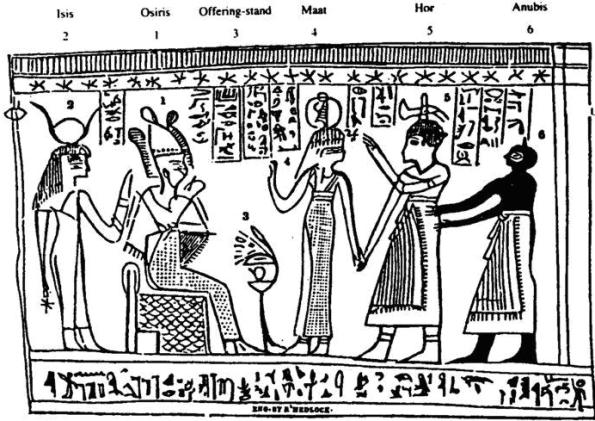
Facsimile No. 3 from the
Book of Abraham
printed from a woodcut by
Ruben Hedlock - the original vignette is
lost. Note especially Figure 2. The above facsimile was derived
from the last vignette of the same Egyptian funerary scroll from
which
Facsimile No. 1 was derived. The
scroll contains
a Book of
Breathings Made by Isis made available to the Prophet Joseph Smith in the Kirtland
period. Figure 2 represents the goddess
Isis/Hathor standing by enthroned
Osiris
(Figure 1). The ancient owner of the scroll is Osiris Hor (Figure 5). The
soul of Hor is
justified before the throne of Osiris. Figure 2 is reinterpreted by the
Prophet Joseph Smith to represent "King Pharaoh, whose name is given in the
characters above his head."
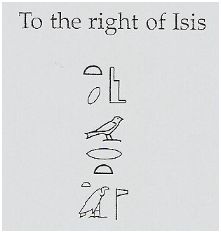
Characters above the head and raised arm of Figure 2
converted to
hieroglyphic Egyptian, a service provided by
Michael Rhodes
(Hor Book of Breathings - A Translation and Commentary, pg. 24). Note the divine
throne
and
swallow
symbols associated with great
Isis (Figure 2). A straight forward
translation of the Egyptian symbols reads, “Isis the great, mother of the
god.”
Robert Ritner notes that "Isis the great, the god's mother" is a
"common" label appearing next to illustrations of Isis. (Ritner, The Joseph Smith Egyptian Papyri - A COMPLETE EDITION, pg. 173)
Isis/Hathor
is mother of the sky god Horus (Hor). Horus imbues the mortal ruler of
Egypt; so an immediate consideration for Pharaoh's title (suggested by symbols above the head of Figure 2) is
Horus (Hor).

Proposed restoration of hieratic characters above the head and raise
arm of Figure 2. by V. Coon. These symbols come from
Moeller's lists which
correlate hieroglyphic and hieratic signs. The hieratic throne symbol (Möller,
Q 383),
bread loaf (Möller,
Y 575),
and hieratic egg symbol
(Möller,
H 238)
are visible at the top of the label.
Other pertinent hieratic signs follow: swallow
(Möller,
G 198),
mouth (Möller,
D 91),
vulture (Möller,
G 193),
temple flag (Möller,
X 547).
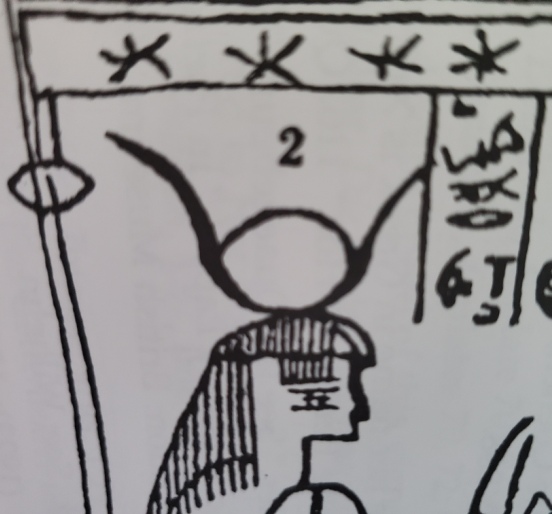
Copied and woodcut
hieratic Egyptian characters above the head
and raised arm of Figure 2. Compare these copied and woodcut
symbols with the hieratic and hieroglyphic equivalents
above. In particular, note that what was originally a hieratic throne symbol (Möller,
Q 383), and hieratic egg symbol
(Möller,
H 238)
distinctly appear as the hieroglyphic feet and tail feather of a falcon perched on a standard
(Gardiner's G7).
In other words, the egg and throne hieratic signs appear to be turned into the bottom parts of a perched falcon on a standard, signifying “Horus” and “king”
(G5, G7).
Who directed Ruben Hedlock to make this remarkably appropriate
interpretation/alteration/substitution? Where did it come from? Compare the partial "falcon
on a standard" hieroglyph  (the
right horn of Hathor's crown points to it) with the
not very similar hieratic versions
(Möller,
G 188). Ryan Larsen
analyzes the partial hieroglyph in his article, "RFM and the Crème de la Crème".
The pharaonic name that Ryan sees in the woodcut can be interpreted to mean
"painful, fierce, angry".
(Genesis 12:16-20) The characters portrayed in the reinterpreted vignette may be seen as figurative,
or archetypal. It took a scholar, trained in ancient Egyptian, to transpose the copied
hieratic symbols into
Egyptian hieroglyphs
(picture symbols) that made sense. The advantage of seeing the equivalent
hieroglyphs, is that they are more easily identified. Once identified, the
characters can be interpreted in other languages; Hebrew for instance.
(the
right horn of Hathor's crown points to it) with the
not very similar hieratic versions
(Möller,
G 188). Ryan Larsen
analyzes the partial hieroglyph in his article, "RFM and the Crème de la Crème".
The pharaonic name that Ryan sees in the woodcut can be interpreted to mean
"painful, fierce, angry".
(Genesis 12:16-20) The characters portrayed in the reinterpreted vignette may be seen as figurative,
or archetypal. It took a scholar, trained in ancient Egyptian, to transpose the copied
hieratic symbols into
Egyptian hieroglyphs
(picture symbols) that made sense. The advantage of seeing the equivalent
hieroglyphs, is that they are more easily identified. Once identified, the
characters can be interpreted in other languages; Hebrew for instance.
Joseph Smith's esoteric, multilingual
"Egyptians" (the
Ah-meh-strah-ans) thought they could see
meanings (and in some cases deliberately assigned meanings) beyond the
standard meanings of Egyptian texts and art.
The
Ptolemaic Ah-meh-strah-ans were apparently the custodians of a version of
the ancient Sepher Avram (Book of Abram), which they
apparently supplemented with Egyptian funerary art, and text. They may have
tried to provide a meaningful Egyptian replacement for at least one lost
illustration that had featured "hieroglyphics". See
Abraham 1:12,
14.
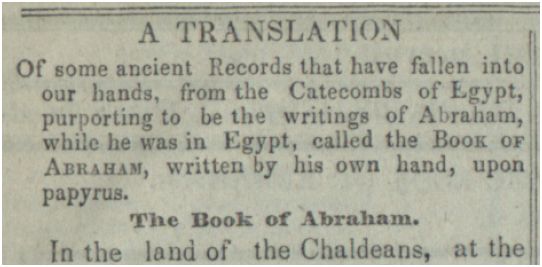
Joseph Smith's original introduction to the
Book of Abraham published in the
March 1, 1842 edition of the
Times and Seasons
newspaper.
Everything Joseph Smith learned about Ah-meh-strah-an symbols and
methods of interpretation, he learned by revelation. The Prophet did not
have an earthly, academic means of interpreting Egyptian characters. To
the Prophet, the scripture "purporting to be the writings of Abraham ...
called THE BOOK OF ABRAHAM" was a work of "present revelation" (Joseph
Smith, Times and Seasons, 1842,
March 1, pg. 704, and
September 1, pg. 902).
The Prophet had performed an earlier, revelatory translation of another
ancient document, a document which he also did not hold in his hands. (LDS
Doctrine and Covenants section 7) Similarly,
Joseph received the text of the Sepher Avram, in English, by
revelation. He supplemented the revealed Book of Abram with
redactions and reinterpretations of Egyptian art and symbols; the kinds
of things the
Ah-meh-strah-ans had done to their lost version(s) of the Sepher
Avram.
In other words, guided by higher intelligence, Joseph went to work
correlating, in Ah-meh-strah-an fashion, the revealed scripture, with
Egyptian funerary art and texts that came into his hands at Kirtland
Ohio. The Book of Abraham correlates with the
Hor Book of Breathings, and the
Shishaq (Sheshanq) Book of the Dead;
but neither of these funerary works contain the Abram scripture's written
source.
Joseph Smith tells us that the Egyptian portions of the Book of
Abraham
were "A
TRANSLATION Of some ancient Records [plural] that have
fallen into our hands, from the Catecombs [Catacombs] of Egypt ..." This
does not mean that the main text of the Book of Abram
(his
name while in Egypt), which was "written by his own hand,
upon papyrus", existed in any obvious, written form on the papyrus scrolls
that Joseph Smith received.
It was Oliver Cowdery, Joseph Smith's less informed assistant, who made
the claim that writings of Abraham and Joseph of Egypt were recorded on the
papyrus rolls. (Messenger
and Advocate, "Egyptian Mummies - Ancient
Records", December 1835, pp. 233-237)
We now know that the ancient papyrus records that Brother Cowdery
described, contain the kind of funerary texts that one expects to find
accompanying Egyptian mummies. No writings on papyrus from Hebrew patriarchs
came with
the mummies to Kirtland.
In an email to colleagues, subject titled:
cracked the pharaoh's name in Facsimile 3, dated 1/17/2022
at 12:45 AM, LDS Scholar Ed Goble wrote the following:
"... the name of pharaoh in facsimile #3 is
Tutmoses. ...
https://en.wikipedia.org/wiki/Thutmose_I
This site shows that the name ThutMose is actually: ḏḥwtj-ms,Tʼaḥawtī-mīsaw,
meaning "Thoth is born".
One symbol for Thoth is the bread loaf, as I
have documented elsewhere, but see this for example:
https://www.egyptianhieroglyphs.net/gardiners-sign-list/
ḏḥwtj-ms,Tʼaḥawtī-mīsaw, meaning "Thoth is born".
Rhodes' transliteration of the text is this:
['Is.t wr.t, mw.t ntr.]
throne-bread-egg-swallow(bird)-mouth-bread-vulture-flag
Q1 X1 H8 G36 D21 G14 R8.
Notice that the last 3 are mouth bread
vulture. I think the mouth is a marker like a cartouche but also like a
pictograph, saying that something will be mouthed or pronounced here.
The key now is bread-vulture.
Here are the Hebrew words for these signs in
succession, similar to when we decoded the Shulem cryptogram:
kisseh lehem betsah
deror peh lehem ozniyyah nes.
Putting the two together, bread and vulture,
we have: lehemozniyyah.
Notice the pronunciation of this part:
lehemoz.
Remember, lehem is bread, a symbol for
Thoth/ḏḥwtj. In other words, a cryptogram between Egyptian and Hebrew
pronunciations: ḏḥwtj-moz, Tutmoses.
It is interesting that an egg is one of the
symbols here, and that the name speaks of Thoth being born. I don't know
what to make of the other parts yet, but I am figuring it out. For now, this
is what I know. Ed "
Commentary on Ed Goble's Discovery
Ed Goble's
transtextual
discovery of a
pharaonic name focuses on a
combination of the bread bun and vulture symbols that Michael Rhodes
transcribed from the characters above the raised arm of Figure
2, Book of Abraham
Facsimile No. 3.
 = “Isis the great, mother of the god.”
= “Isis the great, mother of the god.”
There are actually three bread buns ( ,
Gardiner's X1) seen in Michael Rhodes' transcription. Ed
combines Hebrew words for
bread and
vulture (osprey) which are "lehem"
(לחם)
+ "ozniyah
(עזניה)", to arrive at a version of the string "lehemozniyah".
There is really only one yod (י) in the Hebrew word "ozniyah"
but many think to help the transliteration by doubling the "y".
The vowel sounds are not explicitly written in the Hebrew string.
,
Gardiner's X1) seen in Michael Rhodes' transcription. Ed
combines Hebrew words for
bread and
vulture (osprey) which are "lehem"
(לחם)
+ "ozniyah
(עזניה)", to arrive at a version of the string "lehemozniyah".
There is really only one yod (י) in the Hebrew word "ozniyah"
but many think to help the transliteration by doubling the "y".
The vowel sounds are not explicitly written in the Hebrew string.
If we allow
the Hebrew letter mem (מ,ם) in
the string "lehemozniyah"
to undergo a kind of
mitosis
and split in two (multiplying mem),
we may argue that we hear "lehem-moz..."
Now take the Hebrew word for bread, "lehem"
apart from "moz..." and relate it to a
tall bread loaf
( ,
Gardiner's X2, X3).
The tall loaf of bread signifies the
ibis like moon god
Thoth - father of letters and writing. Substitute "Thoth" for
"lehem"
and you have what sounds like the pharaonic name "Thothmes"
or "Tutmose", variously spelled.
,
Gardiner's X2, X3).
The tall loaf of bread signifies the
ibis like moon god
Thoth - father of letters and writing. Substitute "Thoth" for
"lehem"
and you have what sounds like the pharaonic name "Thothmes"
or "Tutmose", variously spelled.
The tall bread loaf is
similar in shape to the egg hieroglyph. Compare Gardiner's
X3 and
H8. The egg hieroglyph can signify a
begotten "son". This is one of the meanings of the
name of the prince and prophet Mosheh
(משה,
Moses 1:3-4).
is
similar in shape to the egg hieroglyph. Compare Gardiner's
X3 and
H8. The egg hieroglyph can signify a
begotten "son". This is one of the meanings of the
name of the prince and prophet Mosheh
(משה,
Moses 1:3-4).
The pharaonic component name "mose" brings to mind the
name of the great law giver. "Mosheh" has both
Egyptian and Hebrew meanings.
(Exodus 2:10) Could the Hebrew word "mashah"
(משה)
that Mosheh relates to,
have drawn upon an Egyptian word meaning to "birth";
so that the translation, "drew him out of the water" may have originally had
a
connotation suggesting "birthed him out of the water"? (Exodus 2:10,
2 Samuel 22:17,
Psalm 18:16)
Ah-meh-strah-ans might interpret "Thut-mose" or "Thuth-mosis" to
mean "Thoth is Moses".
(John 6:32-33)
You may recall that Moses (Mosheh) was
made as "a god to Pharaoh"
(Exodus 7:1), and
was placed by God as
"ruler" over a
great house.
(Exodus 22:28)
The title Paroh
appearing in Hebrew scripture,
means "great house" in Egyptian. Following the logic of the Apostle Paul, it may be argued that Moses in Abram sat upon the throne of Pharaoh. "For he
[Moses the Levite] was yet in the loins of his father [Abram]".
(Hebrews 7:9-10) It is appropriate then to see in the Hebrew string pharaonic
names with the component "mose".
Though reinterpreted in the Book of Abraham as ostensibly depicting a
scene in mortality,
Facsimile No. 3 was originally the final vignette of the Hor Book of Breathings.
As such, it depicts a scene in the afterlife. Should we combine a post mortal
setting with Ed Goble's discovery of the
Thoth-Moses name, we may be justified in seeing in
Facsimile No. 3,
meek Mosheh
in the afterlife, as ruler of his own great house, letting his
exalted father Avraham
rule, and reason in his throne.
After "moz" or Moses, in
the Hebrew string, is the letter nun
(נ,
to some a serpent, ,
Exodus 4:3),
and after that, the abbreviated sacred name of the Israelite God, Yah.
,
Exodus 4:3),
and after that, the abbreviated sacred name of the Israelite God, Yah.
As for names of mortal Egyptian kings, we may primarily consider the component name "moz" or "mose"
in the string "...lhmoznyah..."
(...לחמעזניה...):
The component name "..mose" is common to the names of many Egyptian rulers,
including
Ahmose.
This pharaonic name, aside from its reference to Ah,
Lah, or
Yah the moon god, might be interpreted by an Ah-meh-strah-an to mean
"Ah-mosheh" = "Brother of Moses".
An Ah-meh-strah-an might also see in the name "Yah-mosheh"
= "Yah of Moses" or "Yah
is the Son". To the Egyptian ear, the Hebrew string "...לחמעז..."
can be pronounced in such a way so as to sound like a reference to the moon
(Lah) and birth (moz), as in the name
Ahmose.
Ed Goble makes a case for historically justifying the pharaonic name "Tutmoses"
converted from the characters to the right of Isis
(Facsimile No. 3, Figure 2). But Ed
also admits that there must be more going on, because so many Hebrew letters
remain; not taking part in his find - so far. See Appendix 2, Ed Goble
Update.
Let's compose a thorough list of the Egyptian symbols
(including all the loaves of bread, even the little bun) and their simple
Hebrew identifications. Here are the symbols of the complete string:
 Gardiner's Q1, throne; Hebrew: "kise" (כסא
,כיסא);
Greek transliteration: "κισα".
Gardiner's Q1, throne; Hebrew: "kise" (כסא
,כיסא);
Greek transliteration: "κισα".
There is a
hidden yod (י) in the ancient Hebrew word
for "seat" or "throne", as if the word is spelled so as to avoid being
interpreted to mean "as
Isis". It is not hard
to imagine Ptolemaic Ah-meh-strah-ans deliberately spelling the Hebrew word
for "throne" with a yod or a vav (ו)
to seat in it a reference to "ise" or "wusa". The
modern Hebrew spelling of Isis is
איזיס,
in imitation of the classical Greek pronunciation Ισις.
The Ptolemaic Ah-meh-strah-ans could have imitated the Hebrew word for
throne (כסא,
"kise") as
"κισα" in Greek, and seen in it a reference to the throne goddess.
 Gardiner's X1, small loaf of bread, "t"
sound; Hebrew: "lehem"
(לחם).
Gardiner's X1, small loaf of bread, "t"
sound; Hebrew: "lehem"
(לחם).
 Gardiner's H8, egg; Hebrew: "beytsah" (ביצה).
Gardiner's H8, egg; Hebrew: "beytsah" (ביצה).
Related to "fine
white Egyptian linen".
Sounds like "house
of the
lamb".
Substitute "lamb" with
lehem from above (John
6:32-33) to see
beyt
lehem. (Micah 5:2)
 Gardiner's G36, swallow,
meaning great; Hebrew: "deror" (דרור).
Gardiner's G36, swallow,
meaning great; Hebrew: "deror" (דרור).
A continuation on the theme that from the small proceeds the great.
(Alma
37:7,
LDS Doctrine and Covenants
64:34)
The Hebrew word "deror" (דרור)
also connotes
liberty,
freedom. (Leviticus
25:10,
Isaiah 61:1,
John 8:32;
14:6)
 Gardiner's D21, mouth; Hebrew: "peh" (פה).
Gardiner's D21, mouth; Hebrew: "peh" (פה).
 Gardiner's X1, small loaf of bread, "t"
sound; Hebrew: "lehem"
(לחם).
Gardiner's X1, small loaf of bread, "t"
sound; Hebrew: "lehem"
(לחם).
 Gardiner's X1, small bun, "t" sound,
feminine marker;
Hebrew: "lehem"
(לחם).
Gardiner's X1, small bun, "t" sound,
feminine marker;
Hebrew: "lehem"
(לחם).
Multiplied loaves.
 Gardiner's G14, vulture,
meaning mother; Hebrew: "ozniyah" (עזניה).
Gardiner's G14, vulture,
meaning mother; Hebrew: "ozniyah" (עזניה).
 Gardiner's R8, temple flag,
meaning god, divine; Hebrew: "nes" (נס).
Gardiner's R8, temple flag,
meaning god, divine; Hebrew: "nes" (נס).
These are the symbols above the raised arm of
Figure 2. We should not forget to include the symbols directly above the
head of Figure 2. The explanation in
Facsimile No. 3 requires that we include these also.
The crown of the mother goddess
Hathor (worn by
Isis) is a composite of three hieroglyphs:
(1) ox horns
F13, (2) the solar disk emblematic of the
sun god Ra
N5, encircled by (3) a serpent (implicit
uraeus, not seen in the copied vignette)
N6.
 Gardiner's N6, sun with
uraeus, Re. One potential Hebrew homophone
is "raah" (ראה),
meaning look, behold, see.
Gardiner's N6, sun with
uraeus, Re. One potential Hebrew homophone
is "raah" (ראה),
meaning look, behold, see.
 Gardiner's F13, ox horns, meaning
beginning. One potential Hebrew interpretation is "reshit" (ראשית),
used in reference to the cocreator
Hokhmah
(Proverbs
4:7;
8:30). The Hebrew aleph (א),
Greek letter alpha (Α),
first, head, and a reference to the Gods (אלהים),
are all implicit in "reshit"
(ראשית, Genesis 1:1,
Deuteronomy 21:17).
Gardiner's F13, ox horns, meaning
beginning. One potential Hebrew interpretation is "reshit" (ראשית),
used in reference to the cocreator
Hokhmah
(Proverbs
4:7;
8:30). The Hebrew aleph (א),
Greek letter alpha (Α),
first, head, and a reference to the Gods (אלהים),
are all implicit in "reshit"
(ראשית, Genesis 1:1,
Deuteronomy 21:17).
These last three special symbols (two combined in
N6) are directly above the head of Figure
2; making a total of 12 symbols to esoterically process as would inspired
Ah-meh-strah-ans.
Avram preached the
besorah
(good tidings, Isaiah 61:1; later translated "gospel",
Luke 4:18) "unto the Ah meh strahans". See
[1.22]. So their understanding of the
coming of an
anointed savior could have been prophetic and profound.
(Isaiah 19:21-22)
Here then is a complete Hebrew string (anticipating a little Ptolemaic
Greek) derived from the Egyptian symbols relevant to Figure 2:


Facsimile No. 3, Figure 2, Hebrew
String in standard post-exilic Hebrew/Aramaic letters, and just
below it, the same string in
more ancient, phonetic, reformed Egyptian characters. Hebrew reads right to left. The string is 38
Hebrew characters long.
Remember what the explanation to Figure 2 says. It reads,
"King Pharaoh, whose name is given in the characters above his head."
From the symbols of the Hebrew string above, let us see if we can
construct a message that correlates to the Book of Abraham
explanation of
Facsimile No. 3, Figure 2. For instance, we may see in the
available letters of the string, that we can spell
the Hebrew words for Pharaoh
(פרעח)
and King (מלך).
The
post-exilic Hebrew/Aramaic letter koph
(כ ,ך) from the word "kise" (כסא)
takes its final form (koph as it appears at the end of words, ך) in the
word "melek" (מלך).
Among phonetic reformed Egyptian characters (Sinai aleph-bet) there are
no final forms of letters.


Just above is a reordering of the letters from the Figure 2 Hebrew string.
The final nun (ן) in "ben" (בן),
meaning son, comes from the nun (נ) in
"ozniyah" (עזניה),
meaning osprey or vulture (signifying mother
in Egyptian). Each letter is used only once, so the resulting string is
also exactly 38 Hebrew characters long. Because the feminine Hebrew word for
"beginning" is deliberately placed last (Abraham 2:8), and because the word actually
ends with the last letter of the aleph-bet, we may interpret "reshit" (ראשית)
to suggest "the beginning and end".
(Isaiah 48:12,
Revelation
1:8, LDS Doctrine and Covenants 45:7)
It is also important to know that in Ptolemaic times alphanumeric
equivalencies were contemplated in Greek and then in Hebrew.
Greek Isopsephy
and
Hebrew Gematria assigned numerical values to letters. For
example, the eighth letter of the aleph-bet, het (ח,
more anciently
 )
was seen as equal to the number 8. Such equivalency led to an
alphanumeric sensitivity in these languages. Names became associated
with numbers! (Revelation
13:17-18)
)
was seen as equal to the number 8. Such equivalency led to an
alphanumeric sensitivity in these languages. Names became associated
with numbers! (Revelation
13:17-18)
The reordered string then reads:
"This is Pharaoh,
king and child of Egypt (Egyptes), son of Isis. Look to the
sign 8 8 8, the beginning
and end."
The feminine form of the Hebrew word for Egypt ("Mitsraymah",
Genesis 12:10), appears in the line above. This gives the
word a double meaning; either referring to the land of Egypt, or
to "Mitsraymah" ("Egyptes",
Abraham 1:23-25) the ancestral mother of the Hamite Egyptians
according to the Book of Abraham. An earlier spelling of the
substitute name
is preferred over the commonly published "Egyptus" which seems
to feature the Roman masculine ending "us".
Of particular interest is the combination of the Semitic words
ראה לנס = "raah li-nes" = "look to the
sign" which sounds remarkably like the Semitic "Rahleenos, which
signifies hieroglyphics." (Abraham 1:14) The Hebrew "raah li-ness" in fact derives from
Egyptian hieroglyphics: the solar disk,
seraphic serpent(s), .. and what appears to be a
supporting, possibly
sharp
triple cross called
samekh.
The string


 ,
may be read "het het het". The name of each
,
may be read "het het het". The name of each  then includes an unseen
tav (
then includes an unseen
tav ( ).
That is, "het", spelled
).
That is, "het", spelled 
 ,
in Proto-Sinaitic symbols, is pronounced "
,
in Proto-Sinaitic symbols, is pronounced "
 ".
".
The Ah-meh-strah-an minded may see prophetic meaning in the
combination of the Hebrew "




 ",
or "het
het het", and the symbols
",
or "het
het het", and the symbols  that translate
to mean "the
sign".
that translate
to mean "the
sign".
The
saraph
(serpent) and the
samekh spell "nes" (נס)
meaning "sign". But "saraph" calls to mind
"saphar" (ספר)
which means "count". This Hebrew word for "count" happens to be
spelled with its alphanumeric characters
samekh (60), pey (80),
resh (200) in increasing order of numeric value (according to
standard Hebrew Gematria). Additionally, the ancient
samekh
symbol
 pictorially suggests to the mind
the need to put the numbers "in order of
size". Thus a deeper level of meaning, suggested in the Hebrew "nes"
(נס),
guides the Ah-meh-strah-an mind to reorder the
pictorially suggests to the mind
the need to put the numbers "in order of
size". Thus a deeper level of meaning, suggested in the Hebrew "nes"
(נס),
guides the Ah-meh-strah-an mind to reorder the  and implied
and implied  symbols according to the Ah-meh-strah-an
tah rule
- in increasing order:
symbols according to the Ah-meh-strah-an
tah rule
- in increasing order:
 = "nes" = "sign" → "count ("saphar", ספר) in
ascending order"
= "nes" = "sign" → "count ("saphar", ספר) in
ascending order" . Ah-meh-strah-ans
could have recognized this to mean:
. Ah-meh-strah-ans
could have recognized this to mean:






Here the reordered Hebrew/Egyptian characters resemble
Ah-meh-strah-an
prophetic characters
(read left to right). The following
Ah-meh-strah-an number may be perceived:

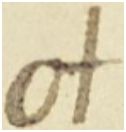



 = "a tah a tah tah a" = 8 + 10x8 + 10x10x8
= "a tah a tah tah a" = 8 + 10x8 + 10x10x8
= 888 = "eight hundred eighty eight".
The sign of the fiery seraph (serpent) and triple cross
samekh pillar or
pole  ,
are interpreted to mean "count in ascending order", that is,
arrange the "
,
are interpreted to mean "count in ascending order", that is,
arrange the "
 "
signs so they express a combination of numbers in ascending order of
greatness. Thus the more ancient symbols (
"
signs so they express a combination of numbers in ascending order of
greatness. Thus the more ancient symbols (


 )
which are behind the
post-exilic Hebrew "נס ח ח ח" = "nes
het het
het" = "sign (in ascending order) 8 8 8",
is fulfilled, or consummated in the number eight hundred eighty eight.
We may then replace
"
)
which are behind the
post-exilic Hebrew "נס ח ח ח" = "nes
het het
het" = "sign (in ascending order) 8 8 8",
is fulfilled, or consummated in the number eight hundred eighty eight.
We may then replace
"


 "
or "נס ח ח ח" with 888 in translation.
"
or "נס ח ח ח" with 888 in translation.
Let us also change the order of the Hebrew words "king" and
"Pharaoh" so that they follow the order in the explanation of Figure 2,
Facsimile No. 3. Joseph's explanation reads "King Pharaoh
..." The Hebrew sentence now read " ... זה מלך פרעה" = "This is King -
Pharaoh ..." which may seam a little redundant until we consider that in
Hebrew, "מלך פרעה" = "King - Pharaoh" can be interpreted to mean "King
of Pharaoh", so that a greater than Pharaoh can be suggested by the order of the words. The
verse now begins to take on a more Messianic meaning, telling of one greater
than Pharaoh, and even greater than Moses who was made "a god" (or placed as the gods by Elohim)
above Pharaoh.
Moreover, let us consider that the name Ισα
= "Isa" (Isis) is a
homophone for the Hebrew word "Ishah" (אשה)
= "Woman" (which includes the Hebrew word for "a man" = "ish"
(אש),
Genesis 2:23).
This is the description of Havah (חוה),
who is "Life", the divine "mother of all living", after
whom Eve was named. (Genesis 3:20,
Moses 4:26)
We note that the Hebrew word for "life" begins with a het, .
.
We may then review and see the Hebrew word string derived from the symbols above
the raised arm and head of Figure 2, as follows:
כיסא לחם ביצה דרור פה לחם לחם עזניה נס ראה ראשית
(κισα)
rearranged as:
זה
מלך
פרעה
וילד
מצרימה
בן
יסא
ראה
לנס
ח ח ח
ראשית
hebraically interpreted as:

which reads
"This is King of a
great house and child of
Egypt,
Son of
Woman. Look to 888, the beginning
and end."
Name of the Father
According to scripture, the "name which is above
every name" is "ΙΗΣΟΥΣ"
("IĒSOUS",
Philippians 2:9-11).
According to
Greek Isopsephy:
Ι = 10, Η = 8, Σ = 200, Ο =
70, Υ = 400, Σ = 200.
Thus ΙΗΣΟΥΣ = 10 + 8 + 200 + 70 + 400 + 200 = 888.
But the name "IĒSOUS"
(ΙΗΣΟΥΣ)
is a Greek spelling of the Hebrew name "Yeshua" (ישוע), meaning
"Salvation" or "he
will save".
(Matthew 1:21,
Job 13:16,
Isaiah 12:2)
The more complete and ancient spelling of this name is
 ,
יהושוע,
"YEHOSHUA", spelled
here with two "nails" (Deuteronomy 3:21) or
"vavim"
(ו,
,
יהושוע,
"YEHOSHUA", spelled
here with two "nails" (Deuteronomy 3:21) or
"vavim"
(ו, used
as "hooks" on which the full weight of the veil of the tabernacle was hung;
Exodus 26:31-32,
Hebrews 10:19-20). This is the name
pronounced "Joshua" in English Bibles. Again, the Greek spelling of Joshua in the
ancient Septuagint is ΙΗΣΟΥΣ.
used
as "hooks" on which the full weight of the veil of the tabernacle was hung;
Exodus 26:31-32,
Hebrews 10:19-20). This is the name
pronounced "Joshua" in English Bibles. Again, the Greek spelling of Joshua in the
ancient Septuagint is ΙΗΣΟΥΣ.
"YEHOSHUA" means
"the Eternal is
Salvation". The name
was revealed by Moses and given to his prophetic successor as a new name. (Number 13:16)
"Endless and
Eternal" is a name of both God the Father and
the Son. (Moses 7:35;
6:57,
LDS Doctrine and Covenants 19:10) This is a divine name of GOD (Elohim) that the Gods (Elohim) command should should not be taken in vain.
(Exodus 20:7)
By replacing 888 = ΙΗΣΟΥΣ, with
the more ancient and original
יהושוע,
 we obtain from the characters above the head of Figure 2, a Messianic message in
pure Hebrew:
we obtain from the characters above the head of Figure 2, a Messianic message in
pure Hebrew:

This may be interpreted:
"This is King of a
great house and child of
Egypt,
Son of
Woman. Look to YEHOSHUA, the beginning
and end."
or alternately:
"This is King of a
great house and child
of
Egypt,
Son of
Woman. Look to YEHOSHUA of
Hokhmah."
since in scripture, Hokhmah
(spelled with a het (ח,
 );
Sophia in Greek) is "reshit"
(ראשית, Proverbs 4:7;
8:30,
Luke 7:35, Matthew 11:19).
But according to Torah, the
Firstborn Son is also
"reshit"
(ראשית,
Deuteronomy 21:17).
Thus we see:
);
Sophia in Greek) is "reshit"
(ראשית, Proverbs 4:7;
8:30,
Luke 7:35, Matthew 11:19).
But according to Torah, the
Firstborn Son is also
"reshit"
(ראשית,
Deuteronomy 21:17).
Thus we see:
"This is King of a
great house and child
of
Egypt,
Son of
Woman. Look to YEHOSHUA
the Firstborn Son."
The expression "child of Egypt" can refer to the house of Israel and/or Messiah. (Exodus 4:22-23,
Hosea
11:1, Matthew 2:15)
But how can the name "YEHOSHUA" ( )
be
"above every name ... to the glory of God the Father"? (Philippians 2:9-11)
)
be
"above every name ... to the glory of God the Father"? (Philippians 2:9-11)
The Messianic title begins with a serpent
sign in "nes" (נס)
 , and ends with horns
, and ends with horns
 in "reshit"
(ראשית).
The horned viper hieroglyph
in "reshit"
(ראשית).
The horned viper hieroglyph  signifies
father
(Gardiner's I9).
In this symbolic sense, the entire Messianic name and title is in father,
"av" (אב,
signifies
father
(Gardiner's I9).
In this symbolic sense, the entire Messianic name and title is in father,
"av" (אב, );
much as son, "ben" (בן,
);
much as son, "ben" (בן, ),
represented by the letter "bet" (ב), is
in
father (אב,
),
represented by the letter "bet" (ב), is
in
father (אב, ,
Aramaic: אבא),
,
Aramaic: אבא), ,
3 Nephi 9:15,
John 14:11). We should recognize that the firstborn is also "Aleph" (א,
,
3 Nephi 9:15,
John 14:11). We should recognize that the firstborn is also "Aleph" (א, ).
).
How then can the name "YEHOSHUA" ( )
be "above every name"? The answer is simple: The name includes and is one
of the ageless names of God the Father. The names and titles of the Son
came from the Father. For said he, "I am come in my father's name ..." (John 5:43)
)
be "above every name"? The answer is simple: The name includes and is one
of the ageless names of God the Father. The names and titles of the Son
came from the Father. For said he, "I am come in my father's name ..." (John 5:43)
“The scriptures inform us that Jesus said, As the Father hath power in Himself, even so hath the Son power - to
do what? ...what the Father did. The answer is obvious - in a manner to lay down
His body and to take it up again. Jesus, what are you going to do? To lay down
my life as my Father did, and take it up again. Do you believe it? If you do not
believe it, you do not believe the Bible.” (Joseph Smith, H.C. 6:305-306; Teachings of the Prophet Joseph Smith,
King Follett Discourse, "Power of the Father and the Son", pg. 346)
This then makes sense of Messianic Psalm 110:1, "The
Eternal said unto my Lord, sit thou at
my right hand, until I make thine enemies thy footstool." In this scripture, the Messiah is
referred to as "adoni" = "my Lord". The
Eternal in this verse, is God the Father.
(Mark 12:35-37)
Elder
James E. Talmage,
understood that the translated name "Jehovah" means he that is
Eternal. In Chapter 4 of
Jesus the Christ, Talmage explains that, "Jehovah is the Anglicized rendering of the Hebrew ... signifying
the Self-existent One, or
The Eternal." See
Appendix 1, and consider that the Eternal
name is substituted with "Lord" or "LORD" (KJV) in numerous places throughout LDS Scripture. (Moses 1:3-6;
6:57;
7:35,
50,
53-54,
59-62)

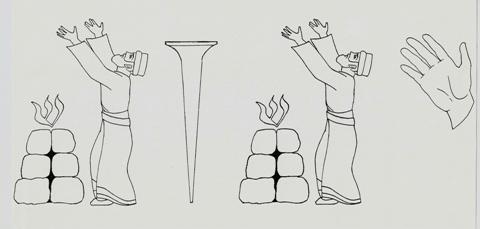
An artistic depiction of the Eternal name and the meaning of each letter
- by V. Coon
כּוּן
Consider ישעיהו,
Isaiah 43:15
Early leadership of the Church, in fact, referred to God the Father
as "The Great Eloheem Jehovah" (See
Proclamation of the Twelve Apostles of the Church of Jesus
Christ of Latter-day Saints, April 6, 1845, and
Genesis 2:4) The name of
Elohim
is
יהוה. (Exodus 3:15)
Identifying the "the LORD"
(Jehovah), or the "LORD God", as God
"our father"
comports well with Hebrew scripture. Compare for example
1 Chronicles 29:10-13, with the Lord's prayer. consider also the Messianic prophecy in
Ezekiel 34:23-24.
According to the Book of Moses, the "Lord God", or
more authentically "Yhvh
Elohim" (Genesis 2:4), is clearly a title of the divine Parent(s) of the Savior.
See
Moses 3:18
in parallel with
Genesis 2:18 (KJV), and especially the Hebrew source
Genesis 2:18.
The Prophet Joseph Smith directly addressed God the Father as "Jehovah",
the "Mighty God of Jacob".
(LDS
Doctrine and Covenants 109:4,
42-51,
54-56,
67-68; consider
3 Nephi 20:12 and
Isaiah 61:1;
63:16)
The Son of God is therefore not the only divine person on whom
the Eternal name "Jehovah"
is bestowed. That the sacred name is given to the messianic messenger, consider Exodus 23:20-21,
Isaiah 26:19,
Jeremiah 23:5-6,
verse 6
in Hebrew.
The Godhead, which includes the Son, is an everlasting Family of unified Gods.
(Alma 11:38-39,
44)
The Heavenly
Family is presided over by the order of "El Elyon", "the Most High God" - the God of
Melchizedek, whose name is
ETERNAL. (Genesis 14:18-20,
Psalm 83:18;
135:5,
LDS Doctrine and Covenants 121:32)
Israelite scripture further describes the Most High as "El elohim
YHVH", "The LORD
God of gods”.
(Joshua 22:22)
Even the "Sh'mah", faithfully recited in Jewish prayer, emphasizing divine
unity, nevertheless uses the plural possessive "Eloheynu", "our Gods".
Translations tend to render the plural as singular.
(Deuteronomy 6:4)
But a plurality can also be
"one".
(Genesis 2:24;
11:6,
Judges 6:16;
20:1, etc.) The Eternal seeks to fully place his name
by ordinance upon his covenant people.
(Numbers 6:26-27,
Abraham 1:18-19)
The Eternal name, as a new name will be
placed upon redeemed Jerusalem. (Ezekiel 48:35)
The
determinative
symbol for eternity (see N16) that goes along with the Egyptian word for eternity, "d.t",
is a symbol of
the earth
( ,
Gardiner's N16). This may be a key to understanding why the
esoteric
Ah-meh-strah-ans, who worshipped the Hebrew God (Isaiah
19:21-22), considered the sacred name of
the Eternal to be bestowed upon the earth in her
cycles. (Facsimile
2, Fig. 1,
TETRAGRAMMAT
,
Gardiner's N16). This may be a key to understanding why the
esoteric
Ah-meh-strah-ans, who worshipped the Hebrew God (Isaiah
19:21-22), considered the sacred name of
the Eternal to be bestowed upon the earth in her
cycles. (Facsimile
2, Fig. 1,
TETRAGRAMMAT N
and EARTH)
N
and EARTH)
Degrees of Meaning
Book of Abraham
Facsimile No. 3 isn't just depicting an historic scene enacted in Egypt in the days of Abram. It
isn't just about a mortal ruler allowing a Hebrew prophet of flesh and blood
to sit on the throne. It is a scene of supernal and transcendent meaning,
extending into the world beyond this. It is a resurrection scene about judgment, justification, endowment and exaltation. It is ultimately about
the King of eternity who saves and exalts Abraham and his seed
( ,
כהנה, "Kehunah" ,
Abraham 2:10-11,
LDS
Doctrine and Covenants 132:28-29), to rule and reign with him
in his throne. (Revelation
3:21)
,
כהנה, "Kehunah" ,
Abraham 2:10-11,
LDS
Doctrine and Covenants 132:28-29), to rule and reign with him
in his throne. (Revelation
3:21)
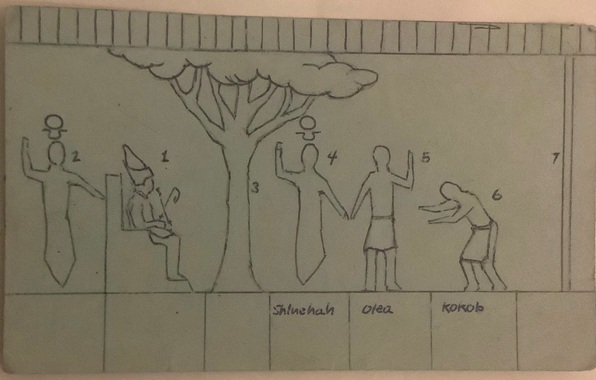
A sketch made by this writer on a 3"x5" card decades ago,
as a young fulltime missionary, and kept in an old set of scriptures.
(Psalm 9:7)
Appendix 1:
From LDS SCRIPTURES, AUTHORIZED VERSION INCLUDING OFFICIAL
STUDY AIDS (CD-ROM RESOURCE 1.0) Transliterated Hebrew | English:

See also the Tetragrammaton
as the name of God the Father in a
Vatican Library Hebrew Gospel of Luke, and
as the name of the Father and the Son in the
Cochin Hebrew Book of Revelation.
Appreciation expressed to
Romolo Simonetti for making
his colleagues aware of these scriptural texts.
Appendix 2:
Ed Goble Update - Who was king of Egypt at the time of Abram?
In an e-mail to colleagues dated October 3, 2024, LDS
scholar Ed Goble proposed that the king of Egypt contemporary with Abram
could have been
Senusret I.
In his own words, Ed proposed that “the Cryptogram of Isis the Great spells out S S WRT, where the strongest consonant in the name EST(Isis) is the S, and over time with the Egyptian pronunciation of Isis, the pronunciation of the T was dropped. And the Egg hieroglyph, normally a determinative for female names, in this case is vocalized with an
S sound. And then the bird hieroglyph (WRT/OoRT, "The Great") So it's once again a double meaning cryptogram: Se-S-OoRet.”
V. Coon responded:
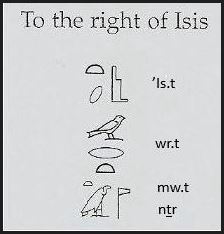
“For the label of Isis (Fig. 2, Facsimile 3)
Michael Rhodes writes … “’Is.t wr.t, mw.t ntr.” = “The great Isis, mother of the god.” [Hor Book of Breathings, pg. 25]
Ritner agrees, but uses somewhat different [transliteration] symbols and translates, “Isis the great, the god’s mother.” The “god” in this case being
Horus. You [Ed] see in Ritner’s “[..]S.t wr(t)”
[The Joseph Smith Egyptian Papyri, pg. 173] the name of an Egyptian king “Senusret”
that seems to fit in a possible time period contemporary with Abram [including a famine during his reign].
Apparently “Senusret” means “Man [Son] of the goddess Wosret”
...”
V. Coon further responded:
“Here’s a link arguing that “Senusret” can be interpreted “son of Wosret”:
[About the Goddess Wosret of Ancient Egypt]
Again:
The name of the goddess can be read first in the cartouche [Senusret], in the understanding that the divine son is “of”
(n-water ripple) the mother. Thus we see that the name
“wsr-s-r:t-z:n”
[see cartouche below] means essentially the same as “Zenwosret” [Senusret].
[Ed Goble recommends resourcing A Ptolemaic Sign-List - Hieroglyphs Used
in the Temples of the Graeco-Roman Period of Egypt and their Meanings,
by Dieter Kurth. Kurth lists wś;
wśr among possible sound values of the
Was-sceptre (Gardiner S40) appearing foremost in the Senusret cartouche below.]
So why couldn’t Ptolemaic
Ah-meh-strah-ans have perceived in the Isis/Hathor label “’Is.t wr.t mw.t ntr.” (Hor Book of Breathing(s)
last vignette) the esoteric meaning “’Is.t
w[s]r.t, mw.t ntr.” = “Iset [is] Wosret, mother (protector) of the divine (Horus/Pharaoh)” implicating the pharaonic name “Senusret” = “son of Wosret”?”
%20Cartouche.JPG)
“So since the name of the goddess can come [be written] first, e.g. “wsr-s-r:t-z:n” = “Wosret
man” (meaning Senusret) as suggested by [Senusret I in Hieroglyphs] Then “… wr.t mw.t ntr” is [only] missing
an “s” sound in suggesting “… Wosret mother of the divine (Horus/Pharaoh)”
[- or so] an Ah-meh-strah-an might say. This essentially fits the Wosret relationship with Horus according to the myth (no need for an explicit n-water ripple). An Ah-meh-strahan-an might see that the “s” sound can come from the goddess Iset providing what is missing: So an Ah-meh-strah-an might read “Iset [is] Wo[s]ret, mother of the divine (Horus/Pharaoh)”, suggesting “Isis/Wosret man (son)”, suggesting “Senusret”.
It takes the whole Isis label and an inspired Ah-meh-strah-an mind to see such a thing. And beside this, an Ah-meh-strah-an sees levels of Hebrew meaning in the label – not to be ignored.”
“Taking the throne symbol (ws, i.e. Wsr = Osiris) and
masculinizing the egg (z, s, meaning son) and suppressing the breadbun
(t, as Ed has suggested) in “Iset” or rather “Ise”
[the bread bun may possibly be taken as a feminine determiner, though
Kurth
lists Ꝫśt =
“Eset”], and combining this with the swallow (wr),
mouth (r), and breadbun (t), an Ah-meh-strah-an may similarly see and pronounce “wsz-wr.t”. This also sounds like “Wosret. Thus we may
[also] read in the Isis/Hathor label “Wosret mother (protector) of the
divine (Horus/Pharaoh)”. This parallels some things [about mortal Pharaoh tied to Horus] that Ryan Larsen has put forward over the years.
We don’t need to audibly simulate the name “ZenWosret” (Senusret) in the Isis/Hathor label to strongly implicate the name “ZenWosret” (Senusret) by the message of the label.
Thus “Wsz-wr.t, mw.t ntr” = “Wosret, mother (protector) of the divine (Horus/Pharoah)” (detected in the label “’Is.t wr.t, mw.t ntr” = “Isis the great, mother of the god”) is arguably equivalent to the cartouche reading
“wsr-s-r:t-z:n”,
which is already accepted as equivalent to “ZenWosret” (Senusret) = “Son of Wosret”.
According to information on line, it is believed that Wosret may have influenced or in some sense evolved into Hathor.
[About the Goddess Wosret of Ancient Egypt] Ryan has pointed out the
Isis/Hathor connection via the horned crown worn by the goddess in
Fig. 2. Thus Isis here personifies divine protection and motherhood in general, including the roles of Wosret/Hathor.”
“Though I think it is not needed to succeed in identifying the
[mortal] king’s name, I have nevertheless attempted a rearrangement of the characters in the Isis/Hathor label of the Book of Breathing(s)
final vignette.”
[Note; may
possibly be seen as a feminine determiner
after
may
possibly be seen as a feminine determiner
after in an attempt to designate a goddess.
Moreover, according to Kurth, the temple banner symbol for god (Gardiner R8), may represent a sound value of n.
Thus more closely simulating the name Senusret, while explicitly giving its meaning:]
in an attempt to designate a goddess.
Moreover, according to Kurth, the temple banner symbol for god (Gardiner R8), may represent a sound value of n.
Thus more closely simulating the name Senusret, while explicitly giving its meaning:]
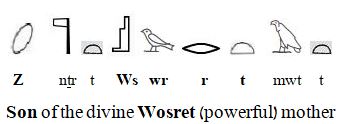
[Utilizing sound values from Kurth's Ptolemaic Sign-List we may
perceive sn-wśwrrt
...]
But there is a deeper [more sublime] question to ask from Fig. 2 Facsimile 3, beyond naming an historic ruler of
Mitsrayim[ah] contemporary with Avram.
The question that should be raised is:
Who really is King of a Great House, according to the Book of Abraham [Facsimile 2] - what is his name?
To properly answer this
Ah-meh-strah-an style, we might delve
[as in this article] into Hebrew equivalents of the characters spelling out “’Is.t wr.t, mw.t ntr” seen
[interpreted from the copied
hieratic] in the last vignette of the Hor Book of Breathing(s):”
In preparation for the answer, consider “Fig. 1
… crown upon his head, representing the Priesthood as emblematical of the
grand Presidency in Heaven; with the scepter of justice and judgment in his
hand.”
It is clear then, that the King, crown and scepter symbolically
relate to “the grand Presidency in Heaven”. The Heavenly King who shares an
everlasting throne with Avraham, whose hand in fact is over his
son
(Fig. 1),
and whose name
(Priesthood) is placed upon him, is the Eternal
Elohim (Abraham 2:8)
-
Jehovah who is
Salvation (Ἰησοῦς = 888).